HONDA RIDGELINE 2012 1.G Owner's Manual
Manufacturer: HONDA, Model Year: 2012, Model line: RIDGELINE, Model: HONDA RIDGELINE 2012 1.GPages: 429, PDF Size: 7.72 MB
Page 21 of 429
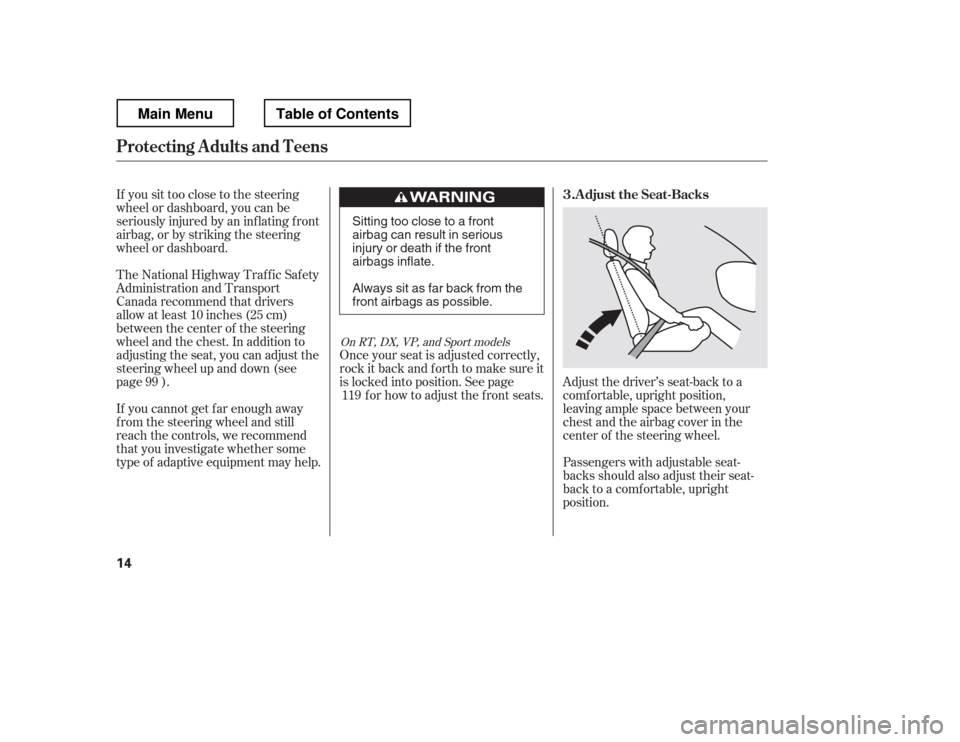
If you sit too close to the steering
wheel or dashboard, you can be
seriously injured by an inf lating f ront
airbag, or by striking the steering
wheel or dashboard.Adjust the driver
Page 22 of 429
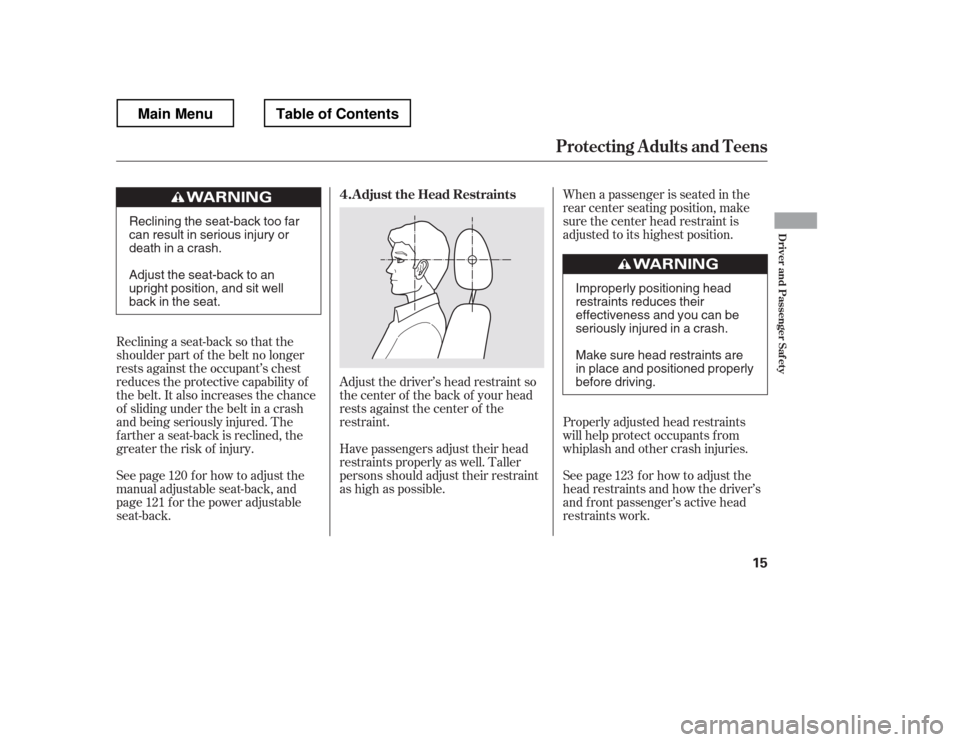
Adjust the driver
Page 23 of 429
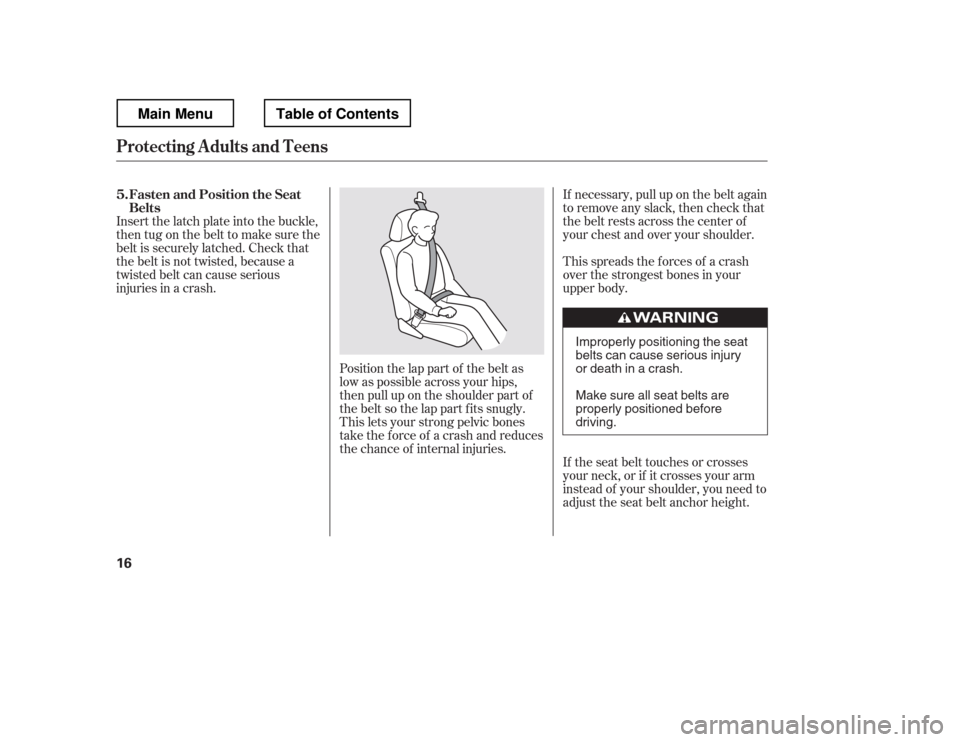
Position the lap part of the belt as
low as possible across your hips,
then pull up on the shoulder part of
the belt so the lap part f its snugly.
This lets your strong pelvic bones
take the force of a crash and reduces
the chance of internal injuries.
Insert the latch plate into the buckle,
then tug on the belt to make sure the
belt is securely latched. Check that
the belt is not twisted, because a
twisted belt can cause serious
injuries in a crash.
If necessary, pull up on the belt again
to remove any slack, then check that
the belt rests across the center of
your chest and over your shoulder.
This spreads the f orces of a crash
over the strongest bones in your
upper body.
If the seat belt touches or crosses
your neck, or if it crosses your arm
instead of your shoulder, you need to
adjust the seat belt anchor height.
Fasten and Position the Seat
Belts
5.
Protecting A dults and Teens
16 Improperly positioning the seat
belts can cause serious injury
or death in a crash.
Make sure all seat belts are
properly positioned beforedriving.
Table of ContentsMain Menu
Page 24 of 429
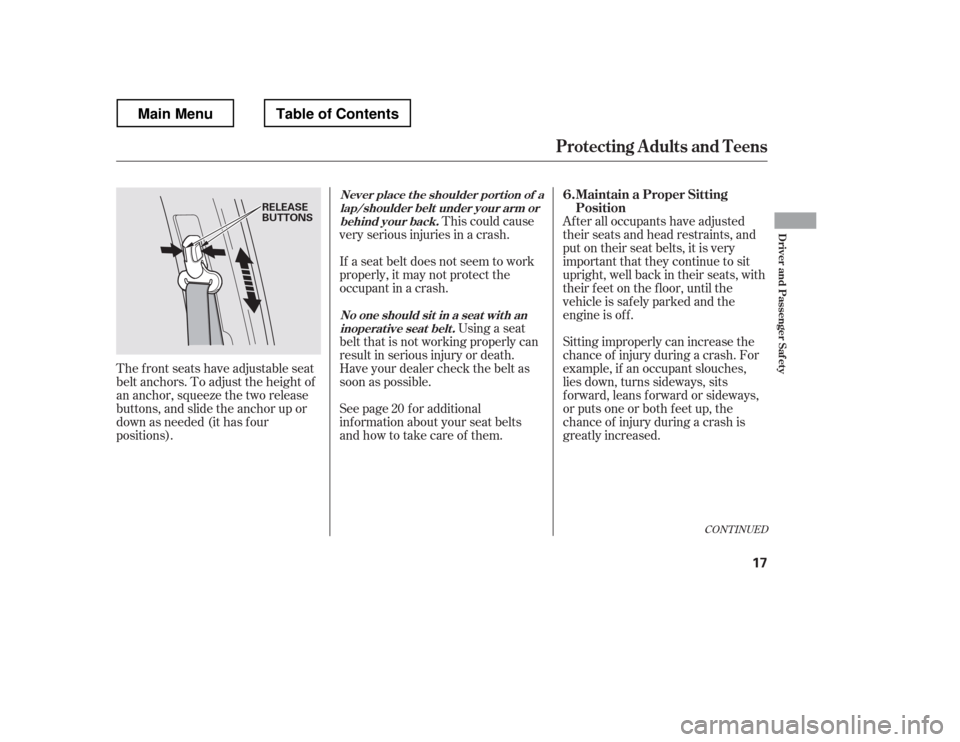
CONT INUED
This could cause
very serious injuries in a crash.
See page f or additional
inf ormation about your seat belts
and how to take care of them.
The front seats have adjustable seat
belt anchors. To adjust the height of
an anchor, squeeze the two release
buttons, and slide the anchor up or
down as needed (it has f our
positions). After all occupants have adjusted
their seats and head restraints, and
put on their seat belts, it is very
important that they continue to sit
upright, well back in their seats, with
their feet on the floor, until the
vehicle is safely parked and the
engine is of f .
Using a seat
belt that is not working properly can
result in serious injury or death.
Have your dealer check the belt as
soon as possible. Sitting improperly can increase the
chance of injury during a crash. For
example, if an occupant slouches,
lies down, turns sideways, sits
forward, leans forward or sideways,
or puts one or both f eet up, the
chance of injury during a crash is
greatly increased.
If a seat belt does not seem to work
properly, it may not protect the
occupant in a crash.
20
Protecting A dults and Teens
Never place t he shoulder port ion of alap/shoulder belt under your arm or behind your back.
No one should sit in a seat with aninoperat ive seat belt .Maintain a Proper Sitting
Position
6.
Driver and Passenger Saf ety
17
RELEASE
BUTTONS
Table of ContentsMain Menu
Page 25 of 429
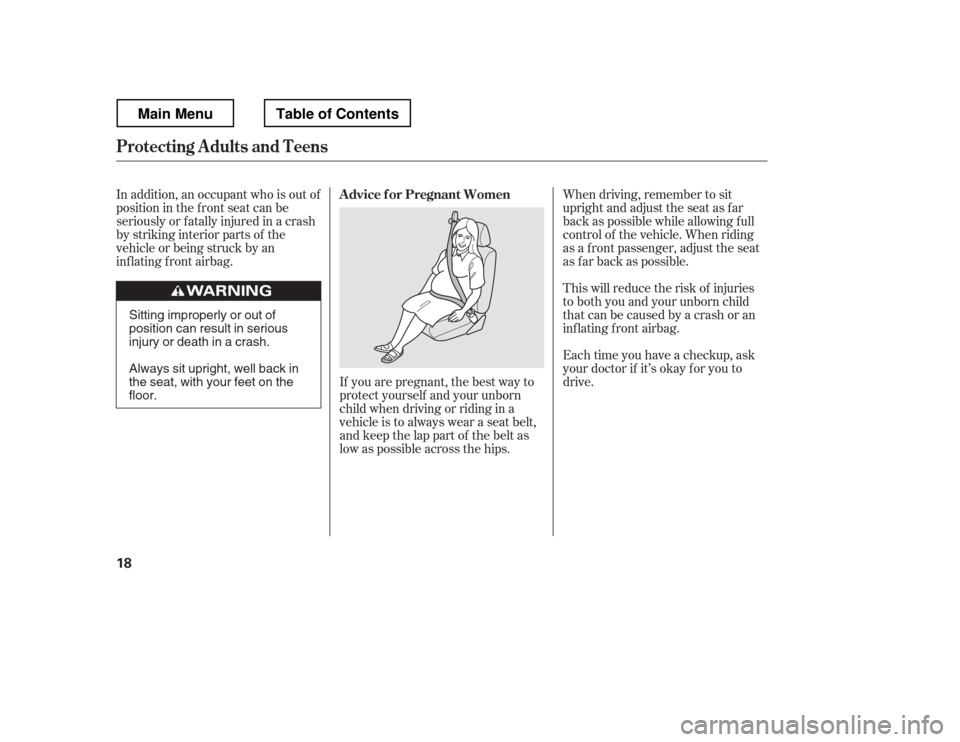
In addition, an occupant who is out of
position in the f ront seat can be
seriously or f atally injured in a crash
by striking interior parts of the
vehicle or being struck by an
inflating front airbag.If you are pregnant, the best way to
protect yourself and your unborn
child when driving or riding in a
vehicle is to always wear a seat belt,
and keep the lap part of the belt as
low as possible across the hips. When driving, remember to sit
upright and adjust the seat as f ar
back as possible while allowing f ull
control of the vehicle. When riding
as a f ront passenger, adjust the seat
as far back as possible.
This will reduce the risk of injuries
to both you and your unborn child
that can be caused by a crash or an
inflating front airbag.
Each time you have a checkup, ask
your doctor if it
Page 26 of 429
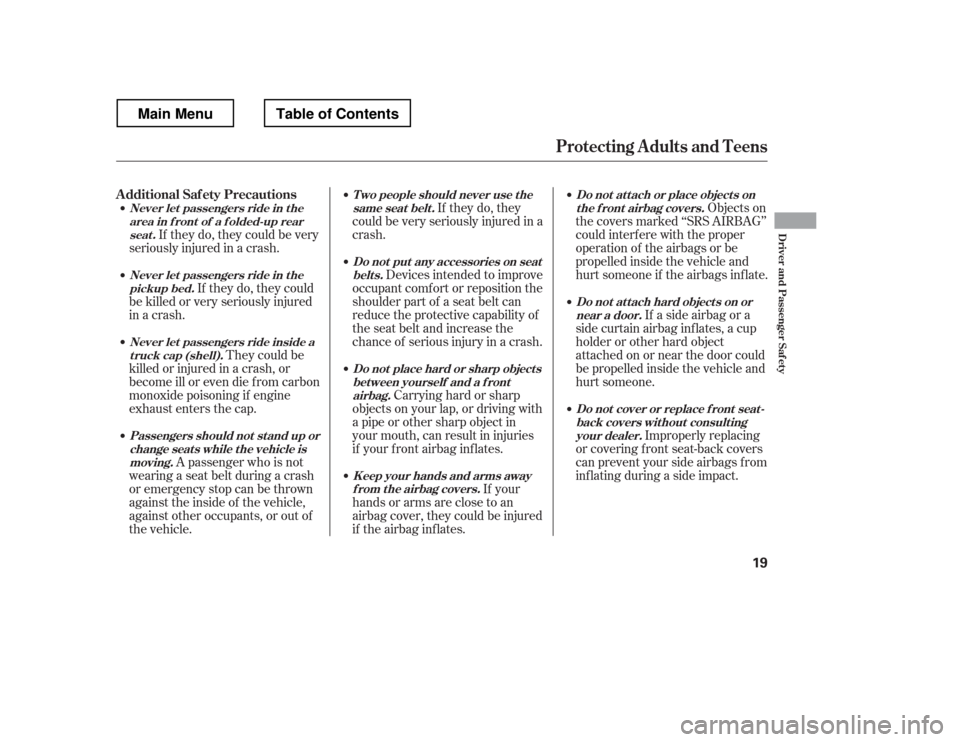
If they do, they could be very
seriously injured in a crash.
If they do, they could
be killed or very seriously injured
in a crash.
They could be
killed or injured in a crash, or
become ill or even die f rom carbon
monoxide poisoning if engine
exhaust enters the cap.
A passenger who is not
wearing a seat belt during a crash
or emergency stop can be thrown
against the inside of the vehicle,
against other occupants, or out of
the vehicle. If they do, they
could be very seriously injured in a
crash.
Devices intended to improve
occupant comf ort or reposition the
shoulder part of a seat belt can
reduce the protective capability of
the seat belt and increase the
chance of serious injury in a crash.
Carrying hard or sharp
objects on your lap, or driving with
a pipe or other sharp object in
your mouth, can result in injuries
if your f ront airbag inf lates.
If your
hands or arms are close to an
airbag cover, they could be injured
if the airbag inf lates. Objects on
the covers marked ‘‘SRS AIRBAG
Page 27 of 429
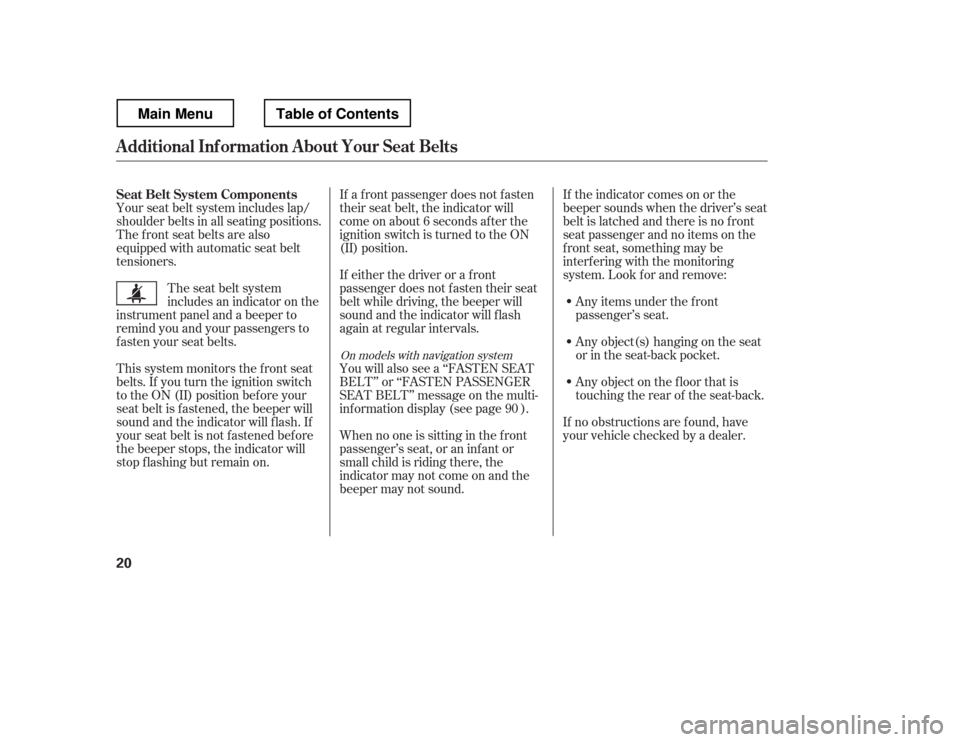
Your seat belt system includes lap/
shoulder belts in all seating positions.
The f ront seat belts are also
equipped with automatic seat belt
tensioners.If the indicator comes on or the
beeper sounds when the driver
Page 28 of 429
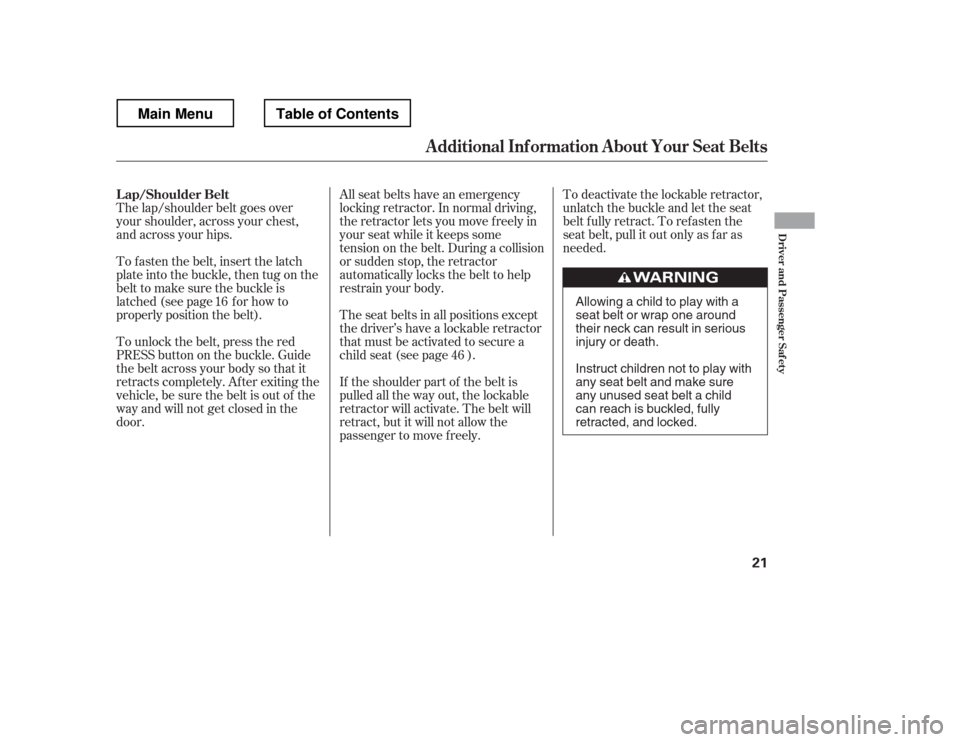
All seat belts have an emergency
locking retractor. In normal driving,
the retractor lets you move f reely in
your seat while it keeps some
tension on the belt. During a collision
or sudden stop, the retractor
automatically locks the belt to help
restrain your body.
The seat belts in all positions except
the driver
Page 29 of 429
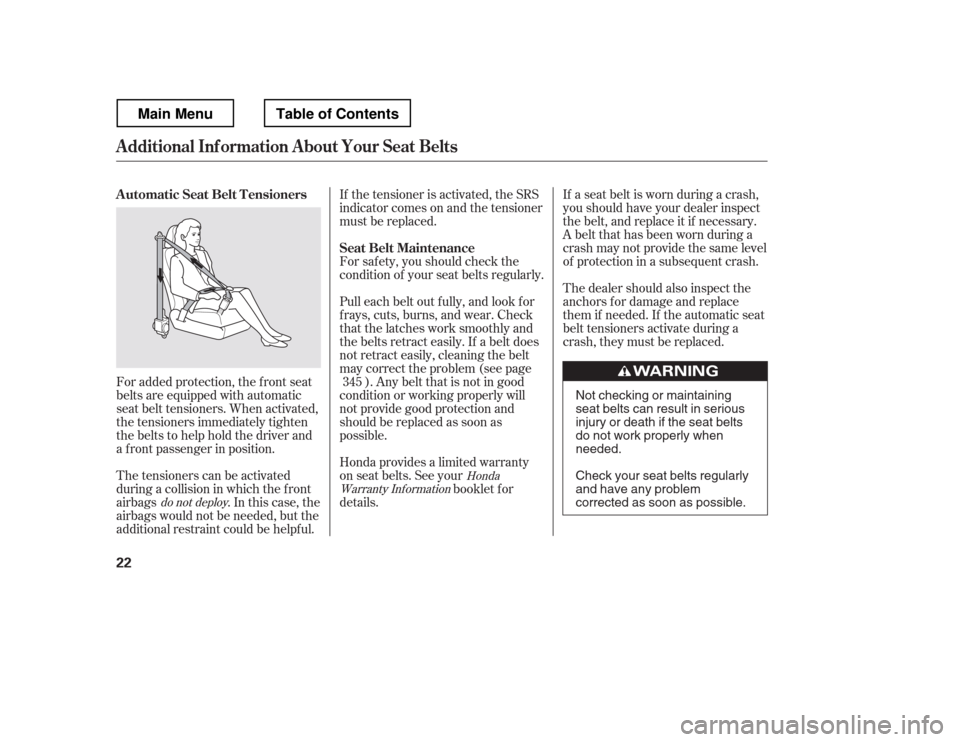
If a seat belt is worn during a crash,
you should have your dealer inspect
the belt, and replace it if necessary.
A belt that has been worn during a
crash may not provide the same level
of protection in a subsequent crash.
The dealer should also inspect the
anchors f or damage and replace
them if needed. If the automatic seat
belt tensioners activate during a
crash, they must be replaced.
If the tensioner is activated, the SRS
indicator comes on and the tensioner
must be replaced.
For saf ety, you should check the
condition of your seat belts regularly.
Pull each belt out f ully, and look f or
f rays, cuts, burns, and wear. Check
that the latches work smoothly and
the belts retract easily. If a belt does
not retract easily, cleaning the belt
may correct the problem (see page
). Any belt that is not in good
condition or working properly will
not provide good protection and
should be replaced as soon as
possible.
Honda provides a limited warranty
on seat belts. See your
booklet f or
details.
For added protection, the f ront seat
belts are equipped with automatic
seat belt tensioners. When activated,
the tensioners immediately tighten
the belts to help hold the driver and
a f ront passenger in position.
The tensioners can be activated
during a collision in which the f ront
airbags . In this case, the
airbags would not be needed, but the
additional restraint could be helpf ul. 345
Honda
Warranty Inf ormation
do not deploy
Additional Inf ormation About Your Seat Belts
Seat Belt Maintenance
A utomatic Seat Belt T ensioners
22
Not checking or maintaining
seat belts can result in serious
injury or death if the seat belts
do not work properly whenneeded.
Check your seat belts regularly
and have any problem
corrected as soon as possible.
Table of ContentsMain Menu
Page 30 of 429
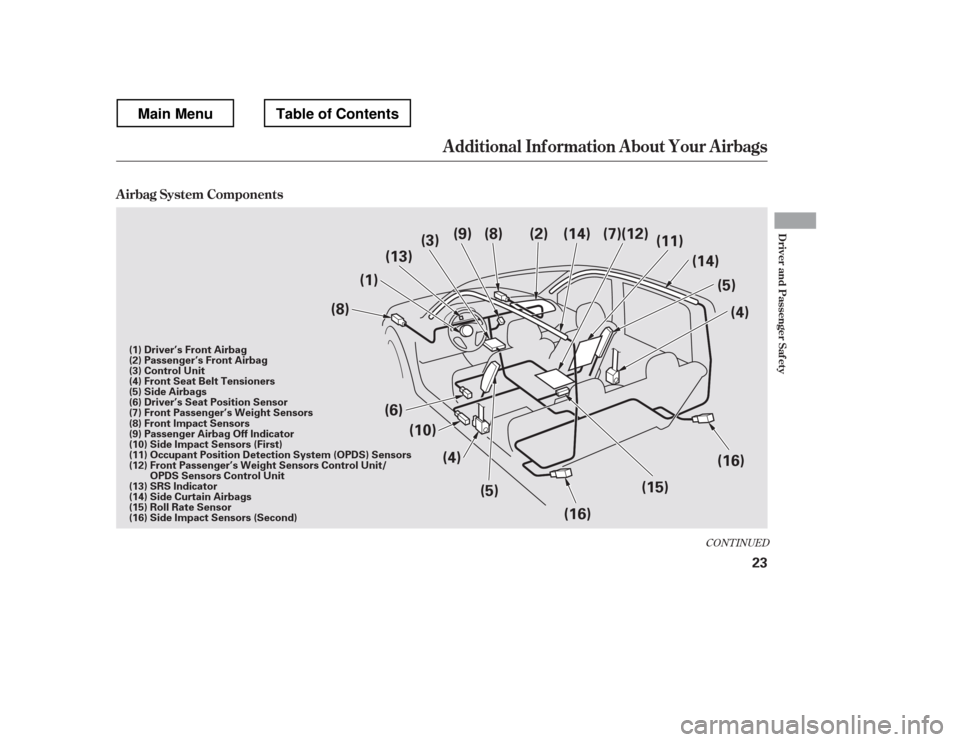
CONT INUED
A irbag System Components
Additional Inf ormation About Your Airbags
Driver and Passenger Saf ety
23
(1)(3)
(5)
(4) (5)
(6)
(10)
(13)
(9) (8) (2)
(16)(4)
(15)
(16)
(8)
(14) (7)(12)
(14)
(11)
(1) Driver’s Front Airbag
(2) Passenger’s Front Airbag
(3) Control Unit
(4) Front Seat Belt Tensioners
(5) Side Airbags
(6) Driver’s Seat Position Sensor
(7) Front Passenger’s Weight Sensors
(12) Front Passenger’s Weight Sensors Control Unit/
OPDS Sensors Control Unit
(13) SRS Indicator
(14) Side Curtain Airbags
(15) Roll Rate Sensor
(16) Side Impact Sensors (Second)
(8) Front Impact Sensors
(9) Passenger Airbag Off Indicator
(10) Side Impact Sensors (First)
(11) Occupant Position Detection System (OPDS) Sensors
Table of ContentsMain Menu